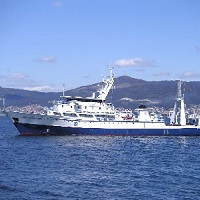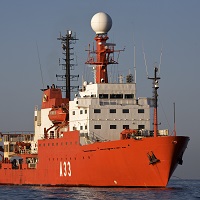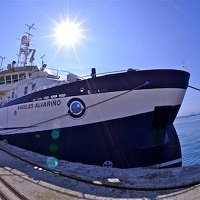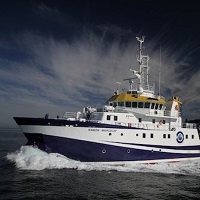Keyword
Concentration of dissolved organic matter in the water column
31 record(s)
Type of resources
Categories
Topics
INSPIRE themes
Keywords
Contact for the resource
Provided by
Years
Formats
Status
-

58 CTD stations performed from 10 to 5200 , depth along trhee transect om N-NW Iberian Peninsula
-

Oceanographyc survey collected in the framework of theSTOCA and INGRES3 projects. STOCA is a program conducting systematic hydrographic and plankton observations along three standard sections in the eastern Gulf of Cadiz. INGRES3 is a Spanish Ministry for Science and innovation funded project that maintains a mooring line at the Spartel sill in the Strait of Gibraltar.
-

FICARAM cruise aims to investigate the evolution of decadal anthropogenic carbon and to evaluate the CO2 uptake capacity in the sector South Atlantic Ocean and its spread to Ecuador and Nord-tropical zone. The section of this cruise is a repeat section following the trace made in 1994 by IFREMER (Laboratoire de Physique des Oceans) into the French project CITHER as a WOCE (http://wwz.ifremer.fr/lpo/Moyens-a-la-mer/Les-campagnes-a-la-mer/Cither-2). This section was repeated in 2001 and 2002 by the Oceanology Group of the Instituto de Investigaciones Marinas of CSIC as part of CAVASSO and CARBOOCEAN European projects. This section is part of the international programs GOSHIP (http://www.go-ship.org/CruisePlans.html) and IOPCC. These programs allow the coordination between the various activities in the global ocean (http://www.go-ship.org/RefSecs/GOSHIPMap_April2011.pdf). The objectives of this cruise are framed in the EU FP7 project CARBOCHANGE (http://carbochange.b.uib.no/) under grant agreement nº 264879. Another important component of FICARAM cruise aims examine the biological and biogeochemical mechanisms that hinder total dissolved organic carbon (DOC) remineralisation in marine systems, taking a multidisciplinary perspective and applying many different approaches. This objective is the global objective of the Spanish project DOREMI that join this FICARAM cruise. Along the section, the DOREMI project will test the effect of different factors (carbon and nutrient additions, and microbial structure) on DOC degradation in epipelagic, mesopelagic and deep waters, developing some experiments determining the potential degradability of mesopelagic and epipelagic DOM, and the role that labile C supplements plays regulating this process and by the microbial structure.
-

The main objective of the project VULcanology CAnaria submariNA, VULCANA, is to study from a physical-chemical, biological and geological point of view submarine volcanoes and hydrothermal systems active or not in the entire Canary basin. In addition, special attention will be paid to the continuity of the studies carried out in the Tagoro submarine volcano on the island of El Hierro, continuing, with one of the longest physical-chemical-biological time series in Spanish territory. The specific objectives of the Vulcana1118-ROV campaign will be: 1. Visualization and sampling around the anchoring carried out during the previous campaign (Vulcana-II-0318). The physical-chemical anchor will recover by autonomous pathways with acoustic release. If these techniques fail, the ROV will be used to completely recover the reinforced concrete block with all its sensors from inside the main crater of the Tagoro submarine volcano, at a depth of 127m. 2. Realization of a uniform regular mesh over the entire Tagoro volcanic building with the ROV for the realization of a complete map of the hydrothermal vents. Physical-chemicalbiological and geological samples of the interior of each of these points will be collected with the use of ROV arms and specifically designed samplers (pressure bottles with on / off valves, inverted funnels, mini-ctds, micro- thermal sensors, etc). 3. Placement and collection of physical instruments in test phase on active hydrothermal environments (areas with physical sensors in self-contained and with automatic release capacity - Kaust). The writing of some task related to this objective would be missing in the established format (objective, methodology, responsible researcher, institution, etc.). 4. Continue monitoring studies of the only active submarine volcano in the degassing phase of Spanish territory, Tagoro underwater volcano, on the island of El Hierro.
-

The main objective of the project "VULcanología CAnaria submariNA, VULCANA", is assess the degree of damage and recovery on the marine ecosystem of the volcano submarine of the island of El Hierro, making it extensible to the volcano "enmedio", between the islands of Gran Canaria and Tenerife. To do this, he held the monitoring of the physico-chemical, biological and geological properties of the submarine process of the island of El Hierro and the submarine volcano "enmedio", giving continuity to the first and only time series data of a multidisciplinary monogenetic submarine volcano in Spanish waters. 1 .- Study of the spatio-temporal variability of physical, chemical and biogeochemical. 2. Evaluation of the impact of the eruption process of trophic lower levels. 3. physiographic, morphological and structural characterization of the seabed associated emissions and adjacent offshore areas.
-

Multidisciplinary campaing for mooring instruments and adquiring samples and variables to: * Know the thermohaline, kinematic, dynamic and biological characteristics of the Gulf of Cadiz. * Study of carbon fluxes between the Atlantic and Mediterranean. * Linking climatology, hydrology and hydrodynamics and the early stages of development of the species associated with the platform, with a focus on species of fishing interest. * Provide data to feed global and regional numerical models. * Generate and distribute a database to know the evolution of marine climate and its resources.
-

The marine ecosystem of the island of El Hierro, one of the richest and most sensitive of the spanish region, is experiencing the consequences of the first recorded underwater eruption in the Canary Islands in the last 500 years of volcanological history. The principal objective of VULCANO is to characterize the marine ecosystem from a physical-chemical-biological approach in order to quantify the environmental impact caused by the eruptive process. This main aim splits into five particular objectives: 1) to characterize the ecosystem before and after the eruption process, 2) to study the spatio-temporal variability of physical, chemical and biogeochemical properties, 3) to evaluate the impact of the eruptive process on lower trophic levels and 4) Characterization of the physiographic, morphological and structural changes on the seafloor associeted to submarine eruptions and 5) the data integration in existing databases, SIG implementation and dissemination by viewers. These objectives will be accomplished through the development of a multidisciplinary working plan which includes the realization of 3 oceanographic cruises and satellite observations.
-

The main objetive of PLOCAN1304 cruise is twofold. On the one hand implement PLOCAN testing bank area, located in NE coast of Gran Canaria island, and on the other hand, doing seasonal sampling of ESTOC (Estacion de Series Temporales Oceánias de Canarias), which represents PLOCAN node oceanic observatory, located 60 nautical miles north of Gran Canaria island.
-

Multidisciplinary campaing for mooring instruments and adquiring samples and variables to: * Know the thermohaline, kinematic, dynamic and biological characteristics of the Gulf of Cadiz. * Study of carbon fluxes between the Atlantic and Mediterranean. * Linking climatology, hydrology and hydrodynamics and the early stages of development of the species associated with the platform, with a focus on species of fishing interest. * Provide data to feed global and regional numerical models. * Generate and distribute a database to know the evolution of marine climate and its resources.
-

Study the role of B vitamins on the community structure, activity and succesion of the microbial plankton in a coastal upwelling system.
 Catálogo de datos del IEO
Catálogo de datos del IEO